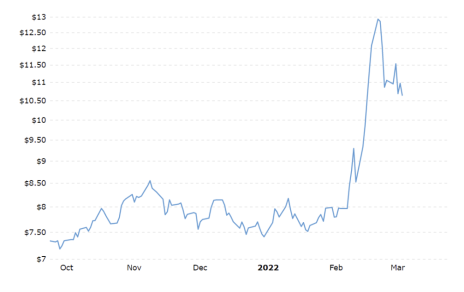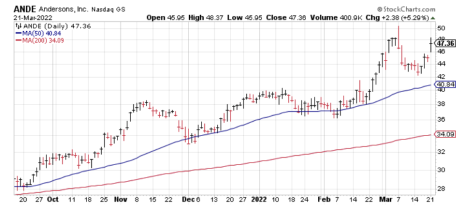Russia’s invasion of Ukraine has disrupted millions of lives, the global order, Western security policy and markets around the world. Endless ink has been spilled on the impact on oil prices and natural gas prices, but the disruption doesn’t stop there.
The London Metal Exchange halted trading in nickel because of disruptions to the market, before ultimately reversing $3.9 billion worth of trades due to the risk of significant short positions being squeezed and unable to cover.
Lost in those headlines is the enormous impact the conflict has had on grain prices. Wheat, specifically, has reached record highs above $12 a bushel, although they’ve calmed slightly since. Even having come off the recent highs, wheat prices are roughly 50% above where they were six months ago. As with rising oil prices, this is bad news for consumers but is a significant boost to wheat stocks.
Why has the Russia/Ukraine situation had such a profound impact on wheat prices specifically? Because those two countries account for about 30% of the world’s traded wheat, and right now those wheat supplies are essentially cut off from the rest of the world, thanks to the war. As a result, wheat prices are spiking to levels not seen before.
Take a look at this six-month wheat price chart, courtesy of Macro Trends:
Courtesy: Macrotrends.net
That looks like the opposite of almost every stock chart these days, and even outpaces the 19% rise in oil prices since the war began in late February. And as rising oil prices have boosted energy stocks, soaring wheat prices have buoyed shares of certain publicly traded agriculture and wheat-producing companies.
Here are three wheat stocks I’d recommend buying on momentum today.
3 Stocks to Capitalize on Wheat’s Run-Up
#1: Archer-Daniels-Midland (ADM)
Archer-Daniels-Midland is more an agriculture stock than a wheat stock. Based in Chicago, it’s an agricultural origination and processing company that produces a range of food ingredients, including nuts, oils, beans and, importantly in this case, flour and grains. It’s not a pure play on rising wheat prices specifically, but with food inflation across the board right now – food prices rose 7.8% globally in January, the biggest monthly jump in seven years, according to the Financial Times – ADM (as it is more commonly known) is benefitting from higher prices across the entire food spectrum.
Sales are expected to rise 6.8% in the current quarter, though those estimates were given before the Russia/Ukraine crisis, and thus are likely conservative. In the last 12 months, revenues have improved 28% while earnings have grown more than 13%.
As for ADM stock, it’s up 28% year to date and 13% in the last month to reach new 52-week highs, and yet still trades at just 15 times forward earnings. With a modest dividend yield (1.8%) to boot, this is a solid large-cap stock ($49 billion market cap) to buy for this era of high food inflation.
#2: The Andersons, Inc. (ANDE)
If the Andersons sounds a bit more mom-and-pop than Archer-Daniels-Midland, that’s because it is. Founded in 1947, it’s a small-town Ohio agribusiness company originally known as Andersons Truck Terminal and formerly catered specifically to the grain industry, but has since expanded its offerings to commodity merchandising, renewables and plant nutrients. Still, its trading group is the company’s bread and butter, and whole grains remain one of its biggest trade commodities.
ANDE is a small-cap stock ($1.5 billion market cap), but a relatively low-risk one, trading at 17 times forward earnings coming off a quarter in which the company grew earnings per share by more than 85%. Profit growth is expected to be far more modest in the coming quarters, likely in the 3-4% range. But the stock has plenty of momentum, up 20% year to date, with all the gains coming in the last month.
You could buy on dips and should probably start small given the stock’s size and waning growth.
#3: Bunge Limited (BG)
Another diversified agribusiness and food company, Bunge Limited actually specializes in soybeans (where prices are also going through the roof), but grain trading is close behind. It sells food all over the world, including North America, Europe, India and Brazil; you may be familiar with its Whole Harvest brand.
Sales were up 43% in 2021, while earnings per share improved by 82%. Both figures are expected to slow considerably this year, but the stock is the cheapest on this list at just 10 times forward earnings, pays the highest dividend yield (1.91%), and has plenty of momentum, up 17% year to date and hitting new highs.
As long as wheat and soybean prices stay high, so should BG’s share price.
Bottom Line
Very few stock charts these days look like the three I just showed you. Outside of the energy sector, basically every other sector is down for the year, thanks primarily to inflation and the Russia/Ukraine situation. Food companies, and particularly those that derive a high percentage of their revenues from producing and trading wheat, actually benefit from each of the two things that have been weighing all other stocks down.
So if you’re looking to buy during this time of pervasive uncertainty, these three wheat stocks are among the very few equities I’d recommend at the moment.
Do you own any food inflation plays in your portfolio? Tell us about them in the comments below.




